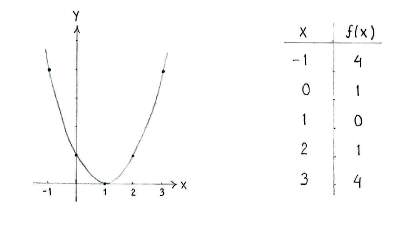Lösung 1.3:2a
Aus Online Mathematik Brückenkurs 2
(Unterschied zwischen Versionen)
K (Solution 1.3:2a moved to Lösung 1.3:2a: Robot: moved page) |
|||
| Zeile 1: | Zeile 1: | ||
| - | + | Lokale Extrempunkte einer Funktion sind entweder: | |
| - | # | + | # stationäre Punkte, wo <math>f^{\,\prime}(x)=0</math>, |
| - | # | + | # Singuläre Punkte, wodie Funktion nicht ableitbar ist, oder |
| - | # | + | # Endpunkte. |
| - | + | Wir untersuchen alle drei Fälle. | |
<ol> | <ol> | ||
| - | <li> | + | <li>Die Ableitung von <math>f(x)</math> ist |
{{Abgesetzte Formel||<math>f^{\,\prime}(x) = 2x-2</math>}} | {{Abgesetzte Formel||<math>f^{\,\prime}(x) = 2x-2</math>}} | ||
| - | + | und ist null wenn <math>2x-2=0</math>, also wenn <math>x=1\,</math>.</li> | |
| - | <li> | + | <li>Nachdem die Funktion ein Polynom ist, ist sie überall ableitbar.</li> |
| - | <li> | + | <li>Die Funktion ist überall definiert, und also hat unser Intervall keine Endpunkte.</li> |
</ol> | </ol> | ||
| - | + | Also sind alle lokalen Extrempunkte auch stationäre Punkte, und also ist <math>x=1\,</math> der einziger Punkt der ein Extrempunkt sein könnte. Wir untersuchen ob der Punkt ein Extrempunkt ist, mit einer Vorzeichentabelle. | |
| - | + | ||
{| border="1" cellpadding="5" cellspacing="0" align="center" | {| border="1" cellpadding="5" cellspacing="0" align="center" | ||
| Zeile 38: | Zeile 37: | ||
|} | |} | ||
| + | Nachdem die Ableitung lings von <math>x=1</math> negativ ist, und rechts von <math>x=1</math> positiv ist, ist <math>x=1</math> ein lokales Minima. | ||
| - | + | Berechnen wir zusätzlich den Funktionswert in einigen Punkten, können wir die Funktion zeichnen. | |
| - | + | ||
| - | + | ||
[[Image:1_3_2a-3(3).gif|center]] | [[Image:1_3_2a-3(3).gif|center]] | ||
Version vom 15:26, 26. Apr. 2009
Lokale Extrempunkte einer Funktion sind entweder:
- stationäre Punkte, wo \displaystyle f^{\,\prime}(x)=0,
- Singuläre Punkte, wodie Funktion nicht ableitbar ist, oder
- Endpunkte.
Wir untersuchen alle drei Fälle.
- Die Ableitung von \displaystyle f(x) ist
und ist null wenn \displaystyle 2x-2=0, also wenn \displaystyle x=1\,.\displaystyle f^{\,\prime}(x) = 2x-2 - Nachdem die Funktion ein Polynom ist, ist sie überall ableitbar.
- Die Funktion ist überall definiert, und also hat unser Intervall keine Endpunkte.
Also sind alle lokalen Extrempunkte auch stationäre Punkte, und also ist \displaystyle x=1\, der einziger Punkt der ein Extrempunkt sein könnte. Wir untersuchen ob der Punkt ein Extrempunkt ist, mit einer Vorzeichentabelle.
| \displaystyle x | \displaystyle 1 | ||
| \displaystyle f^{\,\prime}(x) | \displaystyle - | \displaystyle 0 | \displaystyle + |
| \displaystyle f(x) | \displaystyle \searrow | \displaystyle 0 | \displaystyle \nearrow |
Nachdem die Ableitung lings von \displaystyle x=1 negativ ist, und rechts von \displaystyle x=1 positiv ist, ist \displaystyle x=1 ein lokales Minima.
Berechnen wir zusätzlich den Funktionswert in einigen Punkten, können wir die Funktion zeichnen.

